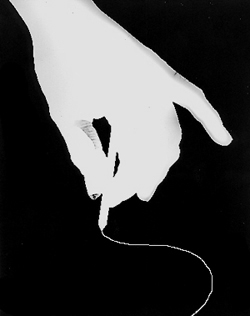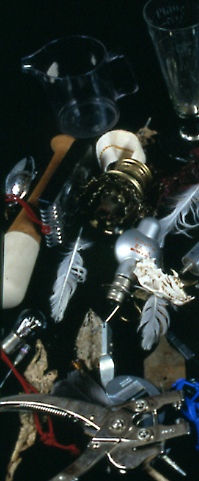 |
Sequence viewing > Index > Photograms
- The ultimate Photogram resource > Resource > ©
Lloyd Godman
Photogram projects by Lloyd Godman - photogram artists
WHAT
ARE PHOTOGRAMS?
The
dictionary interpretation of the word Photogram, is as
follows:
"a
shadowy image produced without a camera by placing
an object in contact with film or photosensitive
material and exposing it to light."
3
"Projections ..... of objects that dream and talk in their sleep"
is how Tristan Tzara
described Man Ray's photograms
Our own bodies are a perfect
example of the photogram in action.
Our
skin is a photosensitive organ, and when we expose it to the sun
there is a pigmentation change - it turns brown. Of course is
we get too much exposure we can also get burnt. By the end of
summer we often see basic images on peoples skin where the sun
has turned the skin brown in some places while those areas covered
remain whiter. In effect these marks create an image as a form
of photogram.

A
simple photogram of a hand, the line in this image is actually
a piece of string laid on the paper |
|
Probably
the most common and simplest form of photogram is a single
object, say a human hand laid on ordinary black & white
photographic paper, exposed to light and then developed
in the normal manner, through a developer, fixer and then
a wash.
Examples
like this are used by many schools to introduce students
to the concept of of light works on sensitive materials
photography.
In
the resulting print the hand appears as a negative silhouette
- white against a black back ground. Where the hand stopped
the light reaching the emulsion, the paper remains white -
where the light reached the paper , it turns black
Like
most photographic processes, it works on the basis that
the action of light
darkens silver. |
SO
WHAT SORT OF OBJECTS CAN WE USE TO MAKE PHOTOGRAMS????
Anyone
can make photograms with a minimum of equipment and knowledge.
Absolutely
any object that transmits, reflects, absorbs or even produces
light can be used to make photograms, and as there is no
need for specialist equipment like a camera film or an enlarger,
it is an excellent method
of learning basic photographic processing principles,
having fun and creating wonderfully haunting images. |
|
 |
Want to learn more? - do a workshop or one on one with Lloyd Godman
|